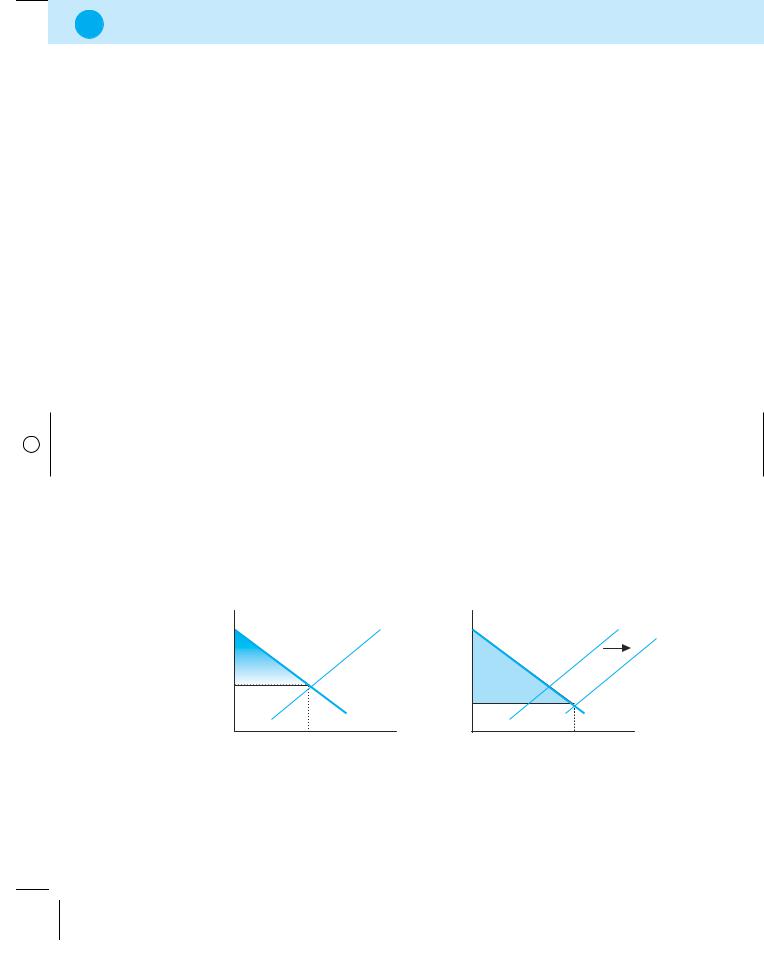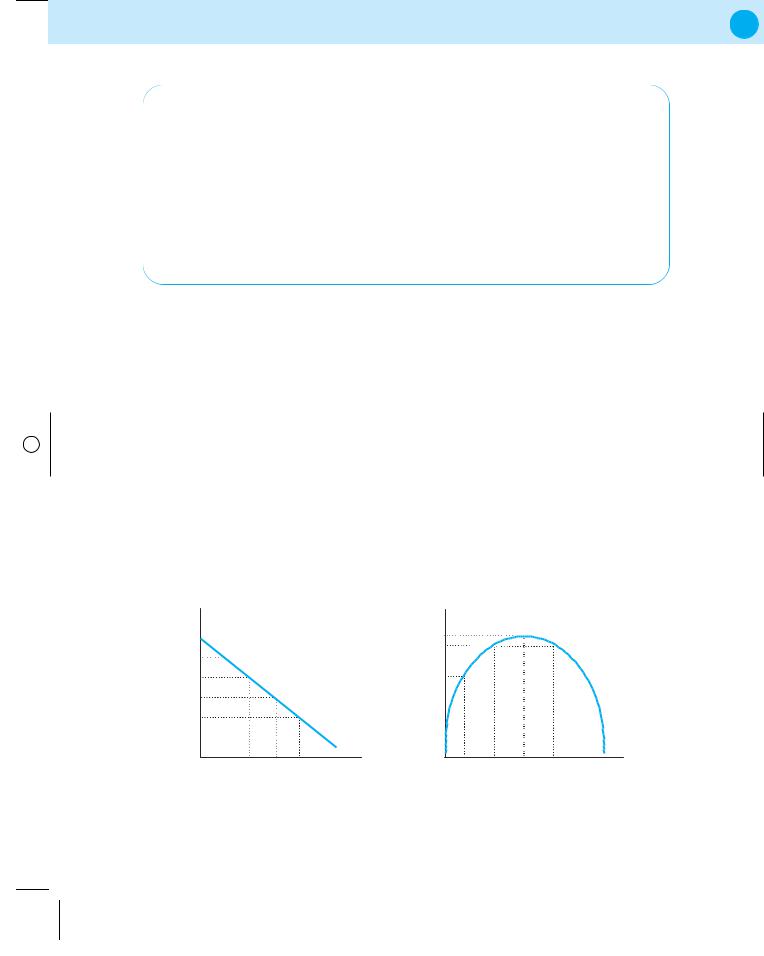
- •1.5.1 The Environment for Economic Decisions
- •2.3 Demand
- •2.4 Supply
- •2.5.1 Changes in Equilibrium
- •2.6.1 Price Ceiling
- •2.6.2 Price Floor
- •2.6.3 Problems of Price Ceilings and Floors
- •2.9.1 Labour Demand
- •2.9.2 Labour Supply: Individual Supply Decision
- •2.9.3 Equilibrium in the Labour Market
- •3.2.1 Consumption Goods
- •3.3.1 The Assumption of Rationality in Economics
- •3.4.1 The Law of Demand – Income and Substitution Effects
- •3.5.1 Consumer Surplus and Consumer Welfare
- •3.6.1 Price Elasticity of Demand
- •3.6.2 Applications of Elasticity Analysis
- •3.6.3 Other Elasticity Examples
- •3.7.1 The Attribute Model: Breakfast Cereals
- •4.3.1 Decisions of Firms and the Role of Time
- •4.3.2 Firm Revenue
- •4.3.3 Firm Output (Product): Marginal and Average Output
- •4.3.4 Firm Costs
- •4.3.5 Marginal and Average Costs
- •4.4.1 Profit Maximization, Normal Profit and Efficiency
- •4.4.2 Maximizing Profits Over the Short Run
- •4.8.1 Using Subsidies – An Example with International Trade
- •4.8.2 Environmental Taxes – Effects on Production
- •4.8.3 Tax Incidence
- •5.3.1 Explanations/Causes of Business Cycles
- •5.3.2 Implications for Business and Government
- •5.4.1 Other Measures of Economic Activity
- •5.4.2 Economic Activity: GNP, GDP and Income
- •5.5.1 The Price Level
- •5.5.2 Aggregate Demand
- •5.5.3 Aggregate Supply
- •5.5.4 Bringing AD and AS Together: The Short Run
- •5.7.1 Explaining Growing International Trade
- •5.7.2 Benefits and Costs of International Trade
- •5.8.1 Another Perspective on Economic Activity: The Economy as a Production Function
- •6.2.1 Competition as a Process
- •6.2.2 Entrepreneurship, Discovery and the Market Process
- •6.3.1 Perfect Competition
- •6.3.2 Monopoly
- •6.3.3 Perfect Competition vs. Monopoly
- •6.3.4 Monopolistic Competition
- •6.3.5 Oligopoly
- •6.5.1 Why Markets May Fail
- •6.5.2 Implications of Market Failure
- •6.6.1 Competition Spectrum
- •6.6.2 Structure, Conduct and Performance
- •6.6.3 Competition Policy
- •7.3.1 The Money Multiplier
- •7.5.1 Which Interest Rate?
- •7.5.2 Nominal and Real Interest Rates
- •7.7.1 Demand in the Foreign Exchange Market
- •7.7.2 Supply in the Foreign Exchange Market
- •7.7.3 Exchange Rate Determination
- •7.7.4 Causes of Changes in Exchange Rates
- •7.8.1 Investment in Bond Markets
- •7.8.2 Bonds, Inflation and Interest Rates
- •7.9.1 Difficulties in Targeting Money Supply
- •7.9.2 Alternative Targets
- •7.9.3 Taylor Rules and Economic Judgement
- •7.10.1 Considering the Euro
- •8.2.1 Labour Market Analysis: Types of Unemployment
- •8.2.2 Analysing Unemployment: Macro and Micro
- •8.2.3 Unemployment and the Recessionary Gap
- •8.2.4 The Costs of Unemployment
- •8.3.1 The Inflationary Gap
- •8.3.2 Trends in International Price Levels
- •8.3.3 Governments’ Contribution to Inflation
- •8.3.4 Anticipated and Unanticipated Inflation – the Costs
- •8.4.1 A Model Explaining the Natural Rate of Unemployment
- •8.4.2 Causes of Differences in Natural Rates of Unemployment
- •8.5.1 Employment Legislation
- •9.2.1 The Dependency Ratio
- •9.4.1 More on Savings
- •9.4.2 The Solow Model and Changes in Labour Input
- •9.4.3 The Solow Model and Changes in Technology
- •9.4.4 Explaining Growth: Labour, Capital and Technology
- •9.4.5 Conclusions from the Solow Model
- •9.4.6 Endogenous Growth

92 |
T H E E C O N O M I C S Y S T E M |
3.5.1CONSUMER SURPLUS AND CONSUMER WELFARE
Welfare economics focuses on assessing the effects of economic policies on both consumers and producers. Such assessments depend to a large extent on the values (or normative judgements) of the assessors because issues of fairness come into play. Issues considered include the conditions under which an economy is most efficient and how goods and income are distributed within economies, and how different economic policies impact on stakeholders. The effect of an economic policy on consumers can be investigated by looking at changes to consumer surplus.
For example, if a government ensures that there is additional competition in the taxi market (by allowing extra taxis to be registered), this could lead to an increased supply of taxis. This is shown in Figure 3.5 as the increase in supply in panel B compared to panel A.
The result of expanded supply (from S1 to S2) with the same demand, is a lower price for taxi fares with a greater quantity supplied: compare P to P and
Q to Q . The welfare effects can be considered by examining consumer surplus (CS) in both cases, which is the area above the price and below the demand curve. At lower taxi fares, in panel B, consumers’ welfare is improved since some consumers unwilling to pay higher taxi fares become willing to demand taxis and those who were willing to pay higher prices still benefit given the gap between the price paid and willingness to pay. Consumer welfare can be said to have increased since a comparison shows that CS1 in panel A is smaller than CS2 in panel B.
A |
|
B |
|
|
Price |
|
Price |
|
S1 |
P |
|
P |
|
|
|
S1 |
|
|
S2 |
|
|
|
|
|
CS1 |
|
|
CS2 |
|
P* |
|
|
|
|
|
|
|
|
|
|
D |
P** |
D |
|
|
Q |
|
|
Q |
Q* |
Quantity |
|
Q** |
Quantity |
F I G U R E 3 . 5 C O N S U M E R W E L F A R E A N D T H E T A X I M A R K E T |
||||

B E Y O N D D E M A N D : C O N S U M E R S I N T H E E C O N O M I C S Y S T E M |
93 |
3 . 6 C O N S U M E R S ’ R E S P O N S E T O P R I C E C H A N G E S
The quantity of goods demanded changes in response to price changes, resulting from new marginal utility/price ratios. If the price of all goods fell by 10% consumers would demand more of most if not all goods, but the rise in demand in response to the price fall would not be the same across all goods. This is because consumers are more or less price-sensitive for some goods relative to others. No matter what price cow’s tongue is I will never choose to increase my demand for it from zero! While individual preferences play a key role in demand decisions and in reactions to price changes we know they are not the only explanatory factor for consumers’ responses to price changes.
A 10% fall in the price of standard pens will not substantially change the quantity demanded for most people since pens are inexpensive and only a small portion of consumers’ income is spent on them. In the case of goods that are not bought very often, and for which the income share is very small, demand is usually not very price-sensitive. This information is useful in drawing a demand curve because it helps us to decide whether the demand curve is relatively steep or flat. For pens the demand curve will be relatively steep indicating that a change in price has little impact on quantity demanded (see panel A in Figure 3.6).
Demand for theatre tickets is somewhat more responsive to changes in price as they can be relatively expensive and are quite a discretionary purchase. Hence, the demand curve is relatively flat such as in panel B in Figure 3.6.
The extent to which substitutes are available for a good also impacts on its pricesensitivity. If the price of one brand of pen were to fall by 10%, rational consumers
A: Pens |
B: Theatre tickets |
|||||||
Price |
|
|
|
Price |
|
|
|
|
|
|
|
|
|||||
P1 |
|
|
|
P1 |
|
|
|
|
P2 |
|
|
|
P2 |
|
|
D |
|
|
|
|
|
|
|
|
||
|
|
D |
|
|
|
|
|
|
|
|
|
Quantity |
|
|
|
|
Quantity |
|
|
|
|
|
Q1 |
|
||
|
|
Q1 Q2 |
|
|
Q2 |
|||
F I G U R E 3 . 6 P R I C E S E N S I T I V I T Y A N D D E M A N D

94 |
T H E E C O N O M I C S Y S T E M |
would substitute away from more expensive pens to the cheaper available brand. For a specific brand, price sensitivity is higher than for a broad category of goods.
In general it is also the case that the higher consumers’ income, the less pricesensitive they are because there are fewer limitations on what can be purchased than for people on lower incomes. This means that the demand curves of higher-income households would be steeper than for lower-income households and their quantities demanded would change relatively little in response to price changes.
The issue of time is also relevant for analysis of price sensitivity since consumers can adjust their purchasing behaviour more easily over longer periods. If one supermarket chain cuts its prices overnight, many people will continue to shop at their usual shops until they become aware of the price cuts elsewhere and until they are willing and able to change their shopping patterns to take advantage of the cheaper prices (clearly convenience, location and other factors matter for the consumer). This may take time but over longer time periods economists expect consumers to be more price-sensitive than over shorter time periods.
F A C T O R S E X P L A I N I N G S E N S I T I V I T Y O F Q U A N T I T Y D E M A N D E D T O P R I C E C H A N G E
Ceteris paribus, sensitivity of quantity demanded to price change is low
•for inexpensive goods;
•for goods with a low income share (e.g. clothes pegs);
•for goods in general rather than a specific good, e.g. all pens vs. Papermate pens;
•for consumers on high incomes;
•over short relative to longer periods.
3.6.1PRICE ELASTICITY OF DEMAND
In the taxi example, when supply expanded the result in equilibrium was a lower price. As predicted by the law of demand, at a lower equilibrium price consumers demanded more taxis. The reaction of quantity demanded can be quantified if information is available on the quantities demanded over a range of prices.
The responsiveness of quantity demanded to a change in price is called the price elasticity of demand (PED).
PED = % Qd/% P

B E Y O N D D E M A N D : C O N S U M E R S I N T H E E C O N O M I C S Y S T E M |
95 |
Price |
|
|
|
|
|
|
|
|
|
|
|
|
|
|
|
||
150 |
|
|
|
|
|
|
|
|
|
|
|
|
Price |
Q (000) |
PED |
||
125 |
Elastic: PED > 1 |
|||||||
|
|
|
||||||
100 |
|
|
|
|
125 |
9 |
–2.5 |
|
75 |
|
|
|
|
100 |
18 |
–1.0 |
|
50 |
|
|
Inelastic: PED < 1 |
75 |
27 |
– 0.5 |
||
|
|
50 |
36 |
|
||||
|
|
|
|
|
|
|||
|
|
|
D |
|
|
|
||
|
|
|
|
Quantity (000) |
|
|
|
|
|
18 |
27 |
36 |
|
|
|
||
|
|
|
|
|
||||
F I G U R E 3 . 7 E L A S T I C I T Y A N D T H E D E M A N D F O R C A L L C R E D I T
If the quantity of taxi rides rose by 10% following a price fall of 5%, price elasticity of demand is −2 (% Qd is 10 and % P is −5 so PED is −2). Demand elasticities are always negative numbers but many economists report demand elasticities without the negative sign, assuming that other economists correctly interpret the number.
As the following example shows, information on elasticity is of particular interest to firms in terms of the effects of price changes on their revenues. Returning to the call credit example, price elasticity can be computed, based on the formula above and the information in Figure 3.7.
•Price rise from £50 to £75: PED = 25%/50% = −0.50
decline in quantity from 36 to 27 is 9, expressed as a percentage of 36 = 25%
price rise of £25, expressed as a percentage of £50 = 50%.
•Price rise from £75 to £100: PED = 33%/33% = −1.00
decline in quantity from 27 to 18 is 9, expressed as a percentage of 27 = 33%
price rise of £25, expressed as a percentage of £75 = 33%. Here, the percentage changes in price and quantity exactly cancel each other out. This is called unit elasticity.
•Price rises from £100 to £125: PED = 50%/20% = −2.50
the decline in quantity from 18 to 9 is 9, expressed as a percentage of 18 = 50%
price rise of £25, expressed as a percentage of £125 = 20%.

96 |
T H E E C O N O M I C S Y S T E M |
PED differs at different points on the demand curve.
In absolute terms (ignoring the minus sign) PED is greater than one when the percentage change in quantity demanded is greater than the percentage change in price. This is elastic PED.
PED is less than one when the percentage change in quantity demanded is less than the percentage change in price. This is inelastic PED.
An alternative estimation method may be used. Instead of computing elasticity relative to one point on the demand function, it can be estimated as an average over a section of the demand function:
Arc price elasticity of demand:
Qd |
× |
|
1/2[P 1 |
+ P 2] |
||
|
P |
1 |
/ |
2[Qd1 |
+ Qd2] |
|
|
|
|
||||
Arc price elasticity differs to the earlier method by estimating average price and average quantity demanded. It is most appropriately used for large price changes.
Re-calculating elasticities from the data above according the arc elasticity method reveals:
• |
Price rise from £50 to £75: Arc PED = − |
9 |
|
× |
|
1/2[50 + 75] |
|
|
|
. |
|||||||||
|
|
|
|
|
|
|
|
|
|||||||||||
25 |
|
1 |
/ |
2[36 + 27] |
= −0 72 |
||||||||||||||
|
|
|
|
|
|
|
|
|
|
||||||||||
• |
|
|
9 |
|
|
|
|
1/2[75 + 100] |
|
|
. |
||||||||
Price rise from £75 to £100; Arc PED = − |
|
|
|
× |
1 |
/ |
2[27 + |
18] |
|
= −1 40 |
|||||||||
|
|
|
25 |
|
|
|
|
|
|
||||||||||
• |
|
|
|
|
9 |
|
|
|
1/2[100 + 125] |
. |
|||||||||
Price rise from £100 to £120; Arc PED = − |
25 |
× |
|
|
1 |
/ |
2[18 |
+ 9] |
|
= −3 00 |
|||||||||
|
|
|
|
|
|
|
|
|
|
|
|
||||||||
Price elasticity of demand and total revenue
If a firm wishes to change the price of a good, it can estimate the impact on the quantity demanded of its product by using PED. Staying with Figure 3.7, if the firm is considering an increase in price it can consider the impact on its revenues. From consumers’ perspectives firm revenue is the same as consumers’ expenditure.
A firm’s total revenue is price times the quantity of goods sold: TR = P × Q

B E Y O N D D E M A N D : C O N S U M E R S I N T H E E C O N O M I C S Y S T E M |
97 |
Example: following Figure 3.7 |
|
|
|
||
P = £0 |
Q = 0 |
TR = £0 |
Price ↑ 0–50 |
TR ↑ |
|
P = £50 |
Q = 36 000 |
TR = £1 800 000 |
|||
P = £75 |
Q = 27 000 |
TR = £2 025 000 |
Price ↑ 50 |
–75 |
TR ↑ |
P = £100 |
Q = 18 000 |
TR = £1 800 000 |
Price ↑ 75 |
–100 |
TR ↓ |
P = £125 |
Q = 9 000 |
TR = £1 125 000 |
Price ↑ 100–125 |
TR ↓ |
|
Conclusion: increasing price can lead to rises in TR OR to falls in TR .
The relationship between quantity demanded, price, elasticity and total revenue is also evident from Figure 3.8. In the elastic part of the demand curve, where quantity demanded is very responsive to changes in price, a fall in price leads to an increase in total revenue.
In the elastic portion of the demand curve, TR changes in the opposite direction to a price change: in the case of a price increase TR falls and in the case of a price fall TR rises.
In the inelastic portion of the demand curve, TR changes in the same direction as a price change implying that if price increases TR rises also.
Changes in the price of a good almost always result in changes in total revenue. The exception is at the point on the demand curve where PED = −1 at point c in panel
A |
|
|
|
|
B |
|
|
|
|
|
Price |
|
|
|
|
TR |
|
|
|
|
|
150 |
Elastic: PED > 1 |
|
2 025 000 |
|
|
c* |
|
d* |
||
|
a |
|
|
1 800 000 |
|
b* |
|
|
||
125 |
|
Unit elastic: |
|
|
|
|
||||
|
|
|
a* |
|
|
|
|
|||
100 |
|
b |
PED = 1 |
1 125 000 |
|
|
|
|
||
|
c |
|
|
|
|
|
|
|||
75 |
|
|
|
|
|
|
|
|
|
|
|
|
|
Inelastic: |
|
|
|
|
|
||
50 |
|
|
d |
|
|
|
|
|
||
|
|
|
PED < 1 |
|
|
|
|
|
||
|
|
|
|
|
|
|
|
|
||
|
|
|
|
|
D |
|
|
|
|
|
|
9 |
18 |
27 36 |
|
Q (000) |
9 |
18 |
27 |
36 |
Q (000) |
F I G U R E 3 . 8 D E M A N D , E L A S T I C I T Y A N D T O T A L R E V E N U E |
||||||||||
